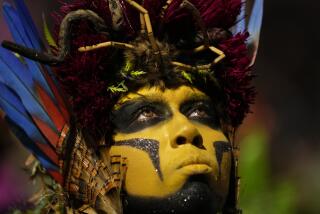Health Problems Imperil Fading Yanomami Tribe
- Share via
RIO DE JANEIRO, Brazil — Academia is still abuzz over a new book charging that a measles vaccine killed hundreds of primitive Amazon Indians three decades ago. But the Yanomami today have other problems, just as deadly.
Chronic malaria and river blindness have decimated and debilitated the Yanomami, endangering the future of the world’s largest remaining Stone Age tribe, Indian experts say.
“Malaria has been catastrophic for the Indians,” said French anthropologist Bruce Albert, who has worked with the tribe for 20 years. “Most of the older Yanomami died and left the young feeling aimless. So many are sick that no one has energy for rituals. It has become a bewildered civilization.”
In “Darkness in El Dorado,” journalist Patrick Tierney charges that geneticist James Neel and anthropologist Napoleon Chagnon inoculated Yanomami with a dangerous vaccine, triggering a 1968 measles outbreak that killed hundreds.
Epidemiologists have rebutted the book’s main charges, saying that the vaccine distributed by the University of Michigan researchers cannot transmit measles, and that the epidemic was underway before the vaccinations began. Still, the controversy has sparked debate about research ethics and refocused international media attention on the Yanomami.
Civilization’s Toll
For the Yanomami, the 1968 measles outbreak is a mere footnote in the tribe’s ongoing struggle to cope with disease and destruction as civilization encroaches ever more rapidly on their Portugal-size reservation straddling the border of Brazil and Venezuela.
“We’ve always had jungle sicknesses that our shamans could cure,” Yanomami chief Davi Kopenawa, 46, said by telephone from Boa Vista, some 2,100 miles northwest of Rio de Janeiro. “But our shamans were helpless against civilization’s diseases. Many of my relatives died soon after white men came.”
Over the last 20 years, malaria and other diseases that arrived with prospectors and other invaders have killed at least 3,000 Indians on the reservation’s Brazilian side.
About a quarter of the nearly 13,000 Indians who live in Brazil came down with malaria last year alone, according to the National Health Foundation.
Aggravating matters, about a third of all Yanomami suffer from river blindness, a disease transmitted by black flies that causes sight-impairing lesions on the eyes. Other symptoms include alligator skin, boils and savage itching.
Though not fatal, the disease often leads to permanent blindness, leaving victims unable to hunt or farm.
Dire Plight
Health workers on the Brazilian side say the situation is even worse in neighboring Venezuela.
“We constantly receive Yanomamis from Venezuela who come to tell us that their relatives are dying,” said Dr. Claudio Esteves, coordinator of Urihi, a private group contracted by the government to provide medical services. “Entire communities travel by foot from long distances to receive attention at our medical posts. Venezuela does nothing for them.”
Brazil does only a little bit more.
Thirteen guard posts set up after the reservation was created in 1992 were dismantled in 1995 because of scarce funds.
“There are no patrols and virtually no government presence on the reservation,” complains Fernando Bittencourt of the NGO Pro-Yanomami Commission. The Brazilian Non-Governmental Organization, or advocacy group, works closely with the Yanomami.
Because of this, many Yanomami are becoming increasingly dependent on the lawless gold miners’ camps for handouts and low-wage work. Earlier this year there were some 4,000 miners illegally camped in different parts of the reservation.
Besides spreading disease, the miners distribute guns and machetes to incite feuding, said Federal Indian Bureau President Glenio Alvarez. Murder is the third leading cause of death among the Yanomami, after malaria and respiratory infections.
The government conducts periodic sweeps to root out prospectors, and although they have had some success, the operations have limited funding. When the money runs out, the miners drift back.
On the positive side, the government spent $6.3 million last year contracting with four NGOs to provide health care on the reservation.
The program funds 243 health workers, including 13 doctors and 24 nurses, who work full-time with the Yanomami. The workers must sometimes hike for days into jungle highlands to reach the most isolated of Brazil’s 188 Yanomami villages.
Urihi, the largest NGO handling 144 villages, has cut mortality rates in half with monthly visits, according to Esteves.
Still, pioneering Indian defender Orlando Villas-Boas worries that the privatization of health care for the Yanomami could lead to a nightmare scenario similar to the one recounted in Tierney’s “Darkness in El Dorado.”
“The Indians will always have unpredictable reactions to our medicine,” Villas-Boas said. “It has to be introduced with great care.”
More to Read
Sign up for Essential California
The most important California stories and recommendations in your inbox every morning.
You may occasionally receive promotional content from the Los Angeles Times.










